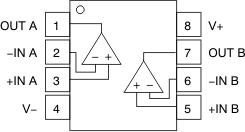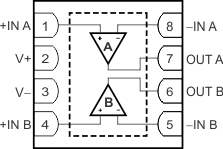JAJSOU7A September 2015 – June 2022 OPA1688
PRODUCTION DATA
- 1 特長
- 2 アプリケーション
- 3 概要
- 4 Revision History
- 5 Device Comparison Table
- 6 Pin Configuration and Functions
- 7 Specifications
- 8 Detailed Description
- 9 Applications and Implementation
- 10Power Supply Recommendations
- 11Layout
- 12Device and Documentation Support
- 13Mechanical, Packaging, and Orderable Information
パッケージ・オプション
メカニカル・データ(パッケージ|ピン)
サーマルパッド・メカニカル・データ
- DRG|8
発注情報
6 Pin Configuration and Functions
 Figure 6-1 D (SOIC-8) Package, Top
View
Figure 6-1 D (SOIC-8) Package, Top
View Figure 6-2 DRG (WSON-8) Package, Top
View
Figure 6-2 DRG (WSON-8) Package, Top
ViewTable 6-1 Pin Functions
| PIN | TYPE | DESCRIPTION | |||
|---|---|---|---|---|---|
| NAME | NO. | ||||
| D (SOIC) |
DRG (WSON) |
||||
| –IN A | 2 | 8 | Input | Inverting input, channel A | |
| –IN B | 6 | 5 | Input | Inverting input, channel B | |
| +IN A | 3 | 1 | Input | Noninverting input, channel A | |
| +IN B | 5 | 4 | Input | Noninverting input, channel B | |
| OUT A | 1 | 7 | Output | Output, channel A | |
| OUT B | 7 | 6 | Output | Output, channel B | |
| V– | 4 | 3 | Power | Negative (lowest) power supply | |
| V+ | 8 | 2 | Power | Positive (highest) power supply | |